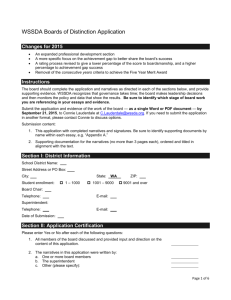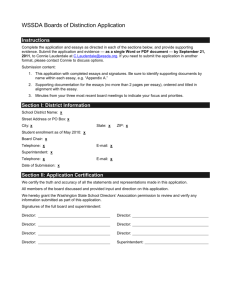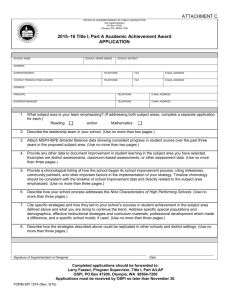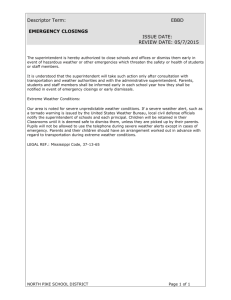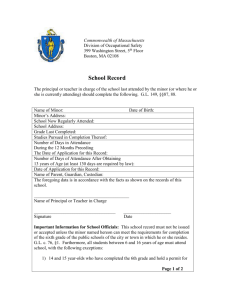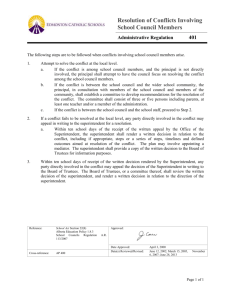WSSDA Boards of Distinction Application
advertisement
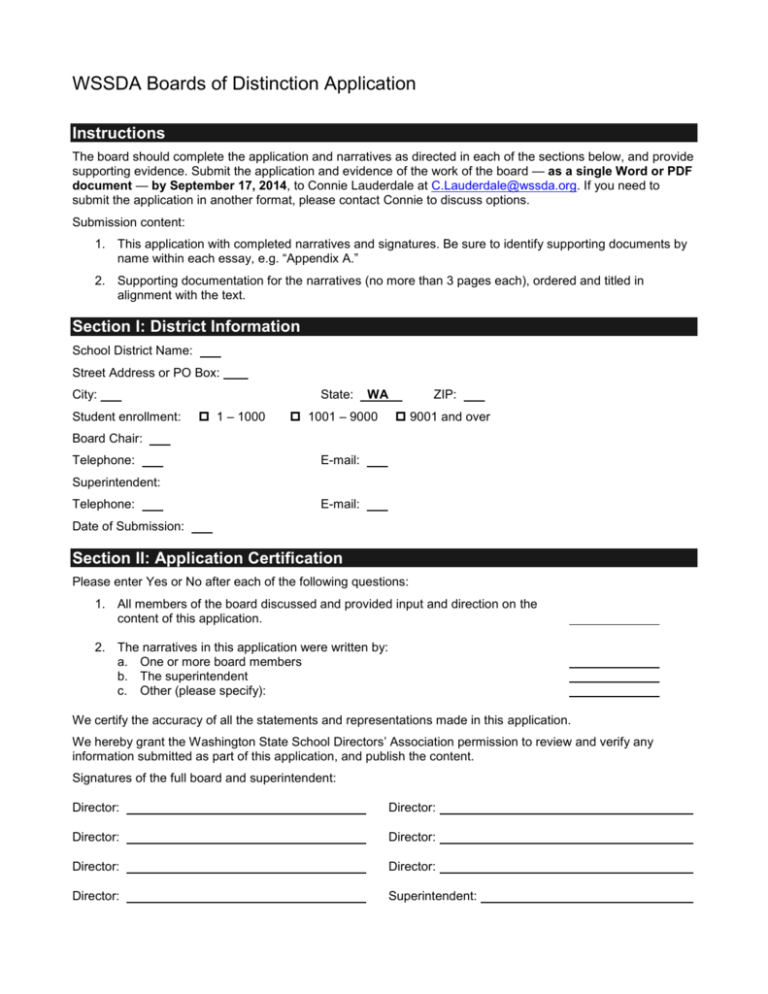
WSSDA Boards of Distinction Application Instructions The board should complete the application and narratives as directed in each of the sections below, and provide supporting evidence. Submit the application and evidence of the work of the board — as a single Word or PDF document — by September 17, 2014, to Connie Lauderdale at C.Lauderdale@wssda.org. If you need to submit the application in another format, please contact Connie to discuss options. Submission content: 1. This application with completed narratives and signatures. Be sure to identify supporting documents by name within each essay, e.g. “Appendix A.” 2. Supporting documentation for the narratives (no more than 3 pages each), ordered and titled in alignment with the text. Section I: District Information School District Name: Street Address or PO Box: City: Student enrollment: State: 1 – 1000 WA 1001 – 9000 ZIP: 9001 and over Board Chair: Telephone: E-mail: Superintendent: Telephone: E-mail: Date of Submission: Section II: Application Certification Please enter Yes or No after each of the following questions: 1. All members of the board discussed and provided input and direction on the content of this application. 2. The narratives in this application were written by: a. One or more board members b. The superintendent c. Other (please specify): We certify the accuracy of all the statements and representations made in this application. We hereby grant the Washington State School Directors’ Association permission to review and verify any information submitted as part of this application, and publish the content. Signatures of the full board and superintendent: Director: Director: Director: Director: Director: Director: Director: Superintendent: Section III: Boardsmanship All WSSDA Boards of Distinction must demonstrate a minimum level of responsible governance. Please underline your answer to each question below. If needed, you may briefly clarify an answer in the Comments section. 1. Each director has no more than one unexcused absence from a regularly scheduled board meeting over the past year. Yes No 2. Each member of the board comes prepared and actively participates in board activities. Yes No 3. The board incorporates the Washington School Board Standards in its work. Yes No 4. The board follows a written vision or plan that has student achievement as a central goal. Yes No 5. The board has completed a self-assessment in the past year. Yes No 6. The board has completed a superintendent evaluation in the past year. Yes No Comments (optional – please be brief): Section IV: Professional Development from WSSDA Boards of distinction should be actively involved in seeking professional development from their member association. Please indicate how many board members attended* each of the following WSSDA events from 9/1/13-9/1/14. *NOTE: These numbers are inclusive. If 3 members attended a spring regional meeting and 5 attended the fall regional meeting, the number of attendees = 8. Event # Board Attendees Workshop or Webinar Topic(s) 1. 2013 WSSDA Annual Conference 2. Regional meeting (fall ‘13/spring ‘14) 3. WSSDA Webinar 4. Individual board workshop Section V: Student Achievement Data Please provide the following information. Reviewers may award bonus points based on this data and/or thoughtful explanations of the data. 1. Embed a copy of your district’s student achievement data page from your district’s OSPI Report Card http://reportcard.ospi.k12.wa.us/summary.aspx. 2. Provide up to one page explanation of what this data suggests. Insert explanation here, underlined. 3. How many of your schools were identified as exemplary in 2012/13, based on the State Board‘s Achievement Index: https://eds.ospi.k12.wa.us/WAI/IndexReport? 4. What percent of your district’s schools attained exemplary status? Section VI: Demonstration of Effectiveness For each of the five benchmarks below, please submit a narrative of no more than 300 words explaining up to three ways in which the board supports that standard.* Indicators for the benchmark being addressed are included for your convenience and to help inform your essays. You might want to review the “Descriptors,” available on the WSSDA Board of Distinction web page. Be sure to address how your board meets the needs of diverse students and steps they are taking to close the achievement gap. Immediately after each narrative, insert no more than three* pages of evidence (e.g., portions of board meeting minutes, protocols, policies, evaluation tools, communications, etc.) to support that narrative. The same piece of evidence may be used to support more than one narrative. Standard 1: Provide responsible school district governance Benchmark: Promoting healthy relationships by communicating supportively, inspiring, motivating and empowering others, and exercising influence in a positive manner. Indicators: 1. Does the board provide an opportunity for staff and students to make presentations to the board? 2. Does the board foster an environment of empowerment to promote a culture of continuous improvement and flexibility throughout the organization? 3. Does the board use its credibility and influence to mobilize resources and accomplish productive work? 4. Does the board promote school board service as a meaningful way to make long term contributions to the community? 5. Does the board treat all individuals, including fellow board members, staff, students and community, with respect? Enter narrative here, with content underlined. Standard 1 evidence: insert up to three pages of evidence below Standard 2: Set and communicate high expectations for student learning, with clear goals and plans for meeting those expectations Benchmark: Articulating the conviction that all students can learn and the belief that student learning can improve regardless of existing circumstances or resources. Indicators: 1. Does the board truly believe that all students can achieve? 2. Does the board articulate high expectations for all students? 3. Does the board engage the community in developing and sustaining the belief that all students can achieve and that improvement in student learning can be made regardless of existing circumstances or resources? 4. Does the board commit to creating the conditions which foster a culture of collaboration around a shared purpose of improving student achievement? Enter narrative here, with content underlined. Standard 2 evidence: insert up to three pages of evidence below Standard 3: Create conditions district wide for student and staff success Benchmark: Adopting and monitoring an annual budget that allocates resources based on the district’s vision, goals and priorities for student learning. Indicators: 1. Does the board keep the community informed about the financial needs of the school district and invite public input during the budget process? 2. Does the board provide guidelines for budget development, including a clearly defined expectation for a reasonable ending fund balance? 3. Does the board adopt a fiscally responsible annual budget that is aligned with the district’s vision and plan? 4. Does the board regularly monitor the budget and fiscal status of the district? Enter narrative here, with content underlined. Standard 3 evidence: insert up to three pages of evidence below Standard 4: Hold school district accountable for meeting student learning expectations Benchmark: Evaluating the superintendent on clear and focused expectations. Indicators: 1. Does the board establish a policy and a process for routine evaluation of the superintendent? 2. Does the board have written performance expectations for the superintendent and communicate those to the community? 3. Does the board solicit appropriate data for the superintendent’s evaluation? 4. Does the board base the decisions about the superintendent’s contract on the objective evaluation of the superintendent’s achievement of performance expectations? Enter narrative here, with content underlined. Standard 4 evidence: insert up to three pages of evidence below Standard 5: Engage local community and represent the values and expectations they hold for their schools Benchmark: Collaborating with families and community members, responding to diverse interests and needs, and mobilizing community resources. Indicators: 1. Does the board provide leadership on educational issues important to the community and advocate on behalf of students and the district? 2. Does the board exhibit cultural, racial and ethnic understanding and sensitivity? 3. Does the board establish partnerships to promote and expand educational opportunities for all students? 4. Does the board foster partnerships with community organizations in the use of facilities and sharing of services? 5. Does the board maintain legislative awareness and communicate with local, state and federal governments in its advocacy role? 6. Does the board follow an established process for referring citizens with questions, concerns, comments or feedback to the appropriate personnel and following up appropriately? Enter narrative here, with content underlined. Standard 5 evidence: insert up to three pages of evidence below
